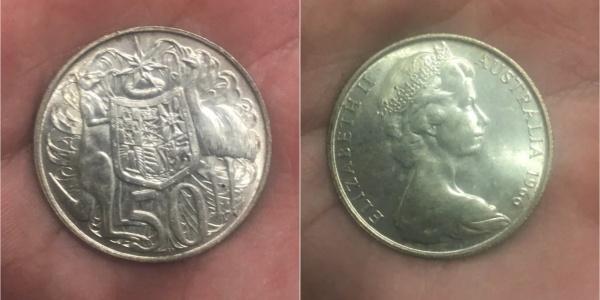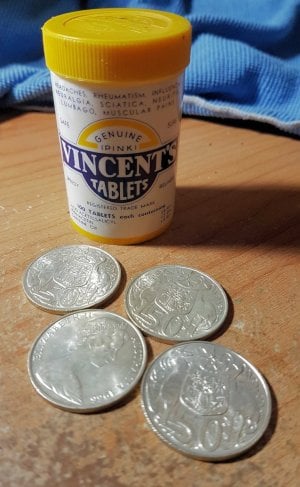Unexpected fortune: Unassuming 50-cent coin unveils a surprising $15 value
By
Seia Ibanez
- Replies 9
The thrill of finding a rare gem in the most unexpected places is a feeling that many treasure hunters and collectors can relate to.
For some, this thrill can come from discovering a rare coin in their loose change.
One such lucky Australian recently stumbled upon a valuable round 50-cent coin worth about $15 in their change, sparking excitement among coin collectors and enthusiasts.
The fortunate finder took to social media to share their discovery, initially mistaking the 1966 coin with a circular edge for a regular 20-cent coin.
'I never knew there used to be round 50 cent coins,' they wrote in the post, alongside an image of the coin.
The post quickly garnered attention, with other users pointing out the coin's rarity and value.
They shared how ‘extremely valuable’ the coin was, noting it is worth $15 alone because of its silver value.
‘Mad luck—like seriously lucky. I wish that happened to me. I had to buy a couple for my collections,’ one person said.
‘Keep it! That’s a valuable piece!’ another commented.
‘Worth well over 50 cents. Haven’t seen one of these since I was a kid,’ a third added.
‘These are extremely valuable. Please keep it,’ a fourth commented.
The round 50-cent coin, introduced in Australia in 1966, is a relic of the past. It was replaced by the dodecagon (12-sided) coins we know today just three years later, in 1969. The reason for the change was simple: the round coin was too similar in size to the 20-cent coin, causing confusion.
But the shape wasn't the only thing that made these coins special. The original 50-cent coins consisted of 80 per cent silver, making the metal in the coin more valuable than the coin's face value.
'People were melting them down and making a profit, so the mint stopped minting them,' explained Perth coin expert Joel Kandiah in a video online.
'36.45 million were minted, but only 14 million [were] put into circulation. [The] rest were melted back into silver,' he added.
You can watch the video below:
According to Kandiah, there are several other valuable coins that Australians should keep an eye out for. These include the 2000 $1 ‘mule’ coin and the 1966 Wavy Baseline 20 cent, both of which could fetch thousands of dollars.
Even more astonishing is the potential value of a five-cent coin made in 2007, which due to a rare printing error, features an image of the Queen’s head on both sides. This coin could fetch its finder around $3000 to $5000.
‘There were a lot of 5c coins minted in 2007,’ Kandiah said.
‘When the mint sets up its press to make coins, the top of the die is the head side, and the bottom is the tail side. But what happened here is the bottom die was also the tail side, so it spit out a double-headed 5c coin.’
If you're lucky enough to come across a valuable coin and are looking to sell, Kandiah recommends finding a coin dealer from the Australasian Numismatic Dealers Association website, which upholds a code of practice.
However, he warned that dealers will likely offer below market price as they need to make a profit on the sale.
‘The only thing is because they’re dealers, they’re going to buy and sell it, so obviously, they’re not going to give you the market price upfront, they’re going to give you maybe 20 to 30 per cent below because they need to make the profit themselves on the sale later on,’ he said.
Other options include Facebook groups, such as Australian Speciality Coins and Collectors of Australia, and auction houses that specialise in coins.
‘You will get market value, and it will take time, but auction houses might be your best option.’
 Have you ever found a rare coin in your change? Did you keep it or sell it? Share your stories with us in the comments below.
Have you ever found a rare coin in your change? Did you keep it or sell it? Share your stories with us in the comments below.
For some, this thrill can come from discovering a rare coin in their loose change.
One such lucky Australian recently stumbled upon a valuable round 50-cent coin worth about $15 in their change, sparking excitement among coin collectors and enthusiasts.
The fortunate finder took to social media to share their discovery, initially mistaking the 1966 coin with a circular edge for a regular 20-cent coin.
'I never knew there used to be round 50 cent coins,' they wrote in the post, alongside an image of the coin.
The post quickly garnered attention, with other users pointing out the coin's rarity and value.
They shared how ‘extremely valuable’ the coin was, noting it is worth $15 alone because of its silver value.
‘Mad luck—like seriously lucky. I wish that happened to me. I had to buy a couple for my collections,’ one person said.
‘Keep it! That’s a valuable piece!’ another commented.
‘Worth well over 50 cents. Haven’t seen one of these since I was a kid,’ a third added.
‘These are extremely valuable. Please keep it,’ a fourth commented.
The round 50-cent coin, introduced in Australia in 1966, is a relic of the past. It was replaced by the dodecagon (12-sided) coins we know today just three years later, in 1969. The reason for the change was simple: the round coin was too similar in size to the 20-cent coin, causing confusion.
But the shape wasn't the only thing that made these coins special. The original 50-cent coins consisted of 80 per cent silver, making the metal in the coin more valuable than the coin's face value.
'People were melting them down and making a profit, so the mint stopped minting them,' explained Perth coin expert Joel Kandiah in a video online.
'36.45 million were minted, but only 14 million [were] put into circulation. [The] rest were melted back into silver,' he added.
You can watch the video below:
According to Kandiah, there are several other valuable coins that Australians should keep an eye out for. These include the 2000 $1 ‘mule’ coin and the 1966 Wavy Baseline 20 cent, both of which could fetch thousands of dollars.
Even more astonishing is the potential value of a five-cent coin made in 2007, which due to a rare printing error, features an image of the Queen’s head on both sides. This coin could fetch its finder around $3000 to $5000.
‘There were a lot of 5c coins minted in 2007,’ Kandiah said.
‘When the mint sets up its press to make coins, the top of the die is the head side, and the bottom is the tail side. But what happened here is the bottom die was also the tail side, so it spit out a double-headed 5c coin.’
If you're lucky enough to come across a valuable coin and are looking to sell, Kandiah recommends finding a coin dealer from the Australasian Numismatic Dealers Association website, which upholds a code of practice.
However, he warned that dealers will likely offer below market price as they need to make a profit on the sale.
‘The only thing is because they’re dealers, they’re going to buy and sell it, so obviously, they’re not going to give you the market price upfront, they’re going to give you maybe 20 to 30 per cent below because they need to make the profit themselves on the sale later on,’ he said.
Other options include Facebook groups, such as Australian Speciality Coins and Collectors of Australia, and auction houses that specialise in coins.
‘You will get market value, and it will take time, but auction houses might be your best option.’
Key Takeaways
- An Australian discovered a rare 1966 round 50-cent coin worth about $15 in their change.
- The round 50-cent coin was mistaken for a 20-cent piece due to its similar size and shape.
- These coins are especially valuable due to their composition of 80 per cent silver and limited circulation.
- Experts advise those who find rare coins to sell through dealers or auction houses to get market value despite the potential for lower initial offers from dealers.









